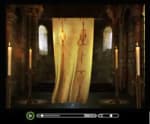Shroud Of Turin
Shroud of Turin - What is it?
The Shroud of Turin is a linen cloth believed by some to have covered the buried body of Jesus Christ. Accounts of Jesus' followers wrapping his body with a linen cloth are mentioned in all four gospels (Matthew 27:59, Mark 15:46, Luke 23:53, John 19:40). The shroud, which has a known history dating back to 1353, is about 14-feet long by four feet wide. It is called the Shroud of Turin because it permanently resides in the city of Turin, Italy, though on occasion it is exhibited elsewhere.
The shroud bears markings that appear to be front and back impressions of a crucified man. Apparently, the cloth was folded over itself, one half above the man, the other half below. Interestingly, the man's wounds are consistent with the wounds inflicted upon Jesus during the torture He endured leading up to His crucifixion. There appear to be wounds around the hairline, matching the biblical description of the crown of thorns. Several small stripe-like wounds extend from the shoulders to the lower legs, matching the biblical description of His torture by whipping. There is also a wound in the area of the chest, which matches the description of the piercing wound inflicted on Jesus shortly after His death.
Shroud of Turin - Expert Explanation
What do experts think about the Shroud of Turin? That depends on who you ask. Some experts consider the Shroud of Turin to be authentic, while others believe that it is a rather sophisticated hoax. A few people have even claimed that the shroud was never intended to be anything more than a work of art. This explanation doesn't seem probable because of the shroud's unique design, a style that had never been observed in any previous major work of art. This fact leads most experts to conclude that the shroud is either authentic or it is purposely designed to look as if it is authentic.
The major critique against the shroud's authenticity is based on carbon dating tests. The tests predict that the shroud is not much more than 700 years old, which would place its origin during the 1300s, making it much too young to have been Jesus' burial cloth. Other scholars suggest that this date might be skewed because the shroud's fibers are soiled with microscopic bacteria and fungi, which have developed for hundreds of years. They believe that the presence of these objects make the shroud test at least a thousand years younger than it really is. There are, however, a growing number of scientists who consider both of these arguments moot because of what they claim to be a lack of reliability in the carbon dating method.
Shroud skeptics also charge that the facial and bodily features of the man are out of proportion. However, other experts argue that many people have certain physical features that are disproportionate.
There are literally dozens of arguments for and against the authenticity of the Shroud of Turin. These contradicting claims may lead the casual observer to conclude that there exists a scientific stalemate concerning the shroud, and that does seem to be the case. So what should we believe about the Shroud of Turin?
Unfortunately, when presented with opposing opinions in a debate related to Christianity, the casual observer tends to accept the non-christian point of view because he believes that it is less influenced by religion, and thus more scientific. However, non-christian scholars often seek to disprove the Christian point of view as fervently as Christian scholars seek to support it. So the non-christian point of view is often very biased. A case in point is the recent discovery of an ancient bone box inscribed with the following message in Aramaic: James, son of Joseph, brother of Jesus. When news of this finding was made public, some scholars, seeking to downplay the historicity of the Christian faith, declared the box a hoax even before they had seen it.
The truth is, no one can say with any degree of certainty that the Shroud of Turin is real or a hoax. The best we can do is analyze all the information, and then decide for ourselves.
Shroud of Turin - The Reality
Sadly, the never-ending debate about the Shroud of Turin is concerned only with its authenticity. In reality, it matters little whether or not the shroud is the burial cloth of Jesus Christ. Either way, the shroud is simply a cloth made of linen. Unfortunately, many people have been misled into thinking that the shroud is in some way sacred, and have thus tied much of their faith to its authenticity. This is a mistake. No matter its origin, the shroud deserves neither our worship nor reverence. Assuming its authenticity certainly makes it a significant part of Christian history, but nothing more.
Jesus lived a perfect life, He died for the sins of mankind, He was raised from the dead, and then He ascended into heaven. By accepting him as Lord and Savior by grace through faith we are forgiven. Christians don't base these beliefs on the Shroud of Turin or any other ancient artifact. Rather, Christians accept these things because of a belief in the truthfulness of the Bible.
The debate over the Shroud of Turin does remind us of one very important point, though. That is, the historicity of the Christian faith. Christianity is not just a set of rules by which Christians govern their lives. It's a relationship with a real God who entered human history as a mortal man, and died so that we might have everlasting life.
What is your response?

